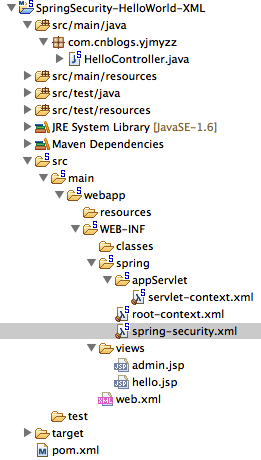本文演示了Spring Security的最最基本用法,二个页面(或理解成二个url),一个需要登录认证后才能访问(比如:../admin/),一个可匿名访问(比如:../welcome)
注:以下内容参考了 http://www.mkyong.com/spring-security/spring-security-hello-world-example/
一、利用STS(Spring Tools Suite)创建一个Spring MVC Project
如果不想使用STS,在普通Eclipse上安装Spring Tool Suite插件也行,用Spring插件创建项目的好处在于,很多配置已经自动帮我们生成好了,基本的项目架子已经具备,不需要在这上面花太多心思,下面是项目结构图

pom文件中的dependencies

1 <?xml version="1.0" encoding="UTF-8"?> 2 <project xmlns="http://maven.apache.org/POM/4.0.0" xmlns:xsi="http://www.w3.org/2001/XMLSchema-instance" 3 xsi:schemaLocation="http://maven.apache.org/POM/4.0.0 http://maven.apache.org/maven-v4_0_0.xsd"> 4 <modelVersion>4.0.0</modelVersion> 5 <groupId>com.cnblogs</groupId> 6 <artifactId>SpringSecurity-HelloWorld-XML</artifactId> 7 <name>SpringSecurity-HelloWorld-XML</name> 8 <packaging>war</packaging> 9 <version>1.0</version> 10 <properties> 11 <jdk.version>1.6</jdk.version> 12 <spring.version>3.2.8.RELEASE</spring.version> 13 <spring.security.version>3.2.3.RELEASE</spring.security.version> 14 <jstl.version>1.2</jstl.version> 15 </properties> 16 17 <dependencies> 18 <!-- Spring dependencies --> 19 <dependency> 20 <groupId>org.springframework</groupId> 21 <artifactId>spring-core</artifactId> 22 <version>${spring.version}</version> 23 </dependency> 24 <dependency> 25 <groupId>org.springframework</groupId> 26 <artifactId>spring-aop</artifactId> 27 <version>${spring.version}</version> 28 </dependency> 29 <dependency> 30 <groupId>org.springframework</groupId> 31 <artifactId>spring-beans</artifactId> 32 <version>${spring.version}</version> 33 </dependency> 34 <dependency> 35 <groupId>org.springframework</groupId> 36 <artifactId>spring-expression</artifactId> 37 <version>${spring.version}</version> 38 </dependency> 39 <dependency> 40 <groupId>org.springframework</groupId> 41 <artifactId>spring-context</artifactId> 42 <version>${spring.version}</version> 43 </dependency> 44 <dependency> 45 <groupId>org.springframework</groupId> 46 <artifactId>spring-context-support</artifactId> 47 <version>${spring.version}</version> 48 </dependency> 49 <dependency> 50 <groupId>org.springframework</groupId> 51 <artifactId>spring-web</artifactId> 52 <version>${spring.version}</version> 53 </dependency> 54 55 <dependency> 56 <groupId>org.springframework</groupId> 57 <artifactId>spring-webmvc</artifactId> 58 <version>${spring.version}</version> 59 </dependency> 60 61 <!-- Spring Security --> 62 <dependency> 63 <groupId>org.springframework.security</groupId> 64 <artifactId>spring-security-core</artifactId> 65 <version>${spring.security.version}</version> 66 </dependency> 67 68 <dependency> 69 <groupId>org.springframework.security</groupId> 70 <artifactId>spring-security-web</artifactId> 71 <version>${spring.security.version}</version> 72 </dependency> 73 74 <dependency> 75 <groupId>org.springframework.security</groupId> 76 <artifactId>spring-security-config</artifactId> 77 <version>${spring.security.version}</version> 78 </dependency> 79 80 <!-- jstl for jsp page --> 81 <dependency> 82 <groupId>jstl</groupId> 83 <artifactId>jstl</artifactId> 84 <version>${jstl.version}</version> 85 </dependency> 86 87 </dependencies> 88 <build> 89 <plugins> 90 <plugin> 91 <artifactId>maven-eclipse-plugin</artifactId> 92 <version>2.9</version> 93 <configuration> 94 <additionalProjectnatures> 95 <projectnature>org.springframework.ide.eclipse.core.springnature</projectnature> 96 </additionalProjectnatures> 97 <additionalBuildcommands> 98 <buildcommand>org.springframework.ide.eclipse.core.springbuilder</buildcommand> 99 </additionalBuildcommands> 100 <downloadSources>true</downloadSources> 101 <downloadJavadocs>true</downloadJavadocs> 102 </configuration> 103 </plugin> 104 <plugin> 105 <groupId>org.apache.maven.plugins</groupId> 106 <artifactId>maven-compiler-plugin</artifactId> 107 <version>2.5.1</version> 108 <configuration> 109 <source>1.6</source> 110 <target>1.6</target> 111 <compilerArgument>-Xlint:all</compilerArgument> 112 <showWarnings>true</showWarnings> 113 <showDeprecation>true</showDeprecation> 114 </configuration> 115 </plugin> 116 <plugin> 117 <groupId>org.codehaus.mojo</groupId> 118 <artifactId>exec-maven-plugin</artifactId> 119 <version>1.2.1</version> 120 <configuration> 121 <mainClass>org.test.int1.Main</mainClass> 122 </configuration> 123 </plugin> 124 </plugins> 125 </build> 126 </project>
二、Controller

1 package com.cnblogs.yjmyzz; 2 3 import org.springframework.stereotype.Controller; 4 import org.springframework.web.bind.annotation.RequestMapping; 5 import org.springframework.web.bind.annotation.RequestMethod; 6 import org.springframework.web.servlet.ModelAndView; 7 8 @Controller 9 public class HelloController { 10 11 @RequestMapping(value = { "/", "/welcome" }, method = RequestMethod.GET) 12 public ModelAndView welcome() { 13 14 ModelAndView model = new ModelAndView(); 15 model.addObject("title", "Welcome - Spring Security Hello World"); 16 model.addObject("message", "This is welcome page!"); 17 model.setViewName("hello"); 18 return model; 19 20 } 21 22 @RequestMapping(value = "/admin", method = RequestMethod.GET) 23 public ModelAndView admin() { 24 25 ModelAndView model = new ModelAndView(); 26 model.addObject("title", "Admin - Spring Security Hello World"); 27 model.addObject("message", "This is protected page!"); 28 model.setViewName("admin"); 29 30 return model; 31 32 } 33 34 }
毫无撸点,二个普通的Action而已,分别对应视图admin.jsp以及hello.jsp
三、web.xml

1 <?xml version="1.0" encoding="UTF-8"?> 2 <web-app version="2.5" xmlns="http://java.sun.com/xml/ns/javaee" 3 xmlns:xsi="http://www.w3.org/2001/XMLSchema-instance" 4 xsi:schemaLocation="http://java.sun.com/xml/ns/javaee http://java.sun.com/xml/ns/javaee/web-app_2_5.xsd"> 5 6 <!-- The definition of the Root Spring Container shared by all Servlets 7 and Filters --> 8 <context-param> 9 <param-name>contextConfigLocation</param-name> 10 <param-value>/WEB-INF/spring/root-context.xml</param-value> 11 </context-param> 12 13 <!-- Creates the Spring Container shared by all Servlets and Filters --> 14 <listener> 15 <listener-class>org.springframework.web.context.ContextLoaderListener</listener-class> 16 </listener> 17 18 <!-- Processes application requests --> 19 <servlet> 20 <servlet-name>appServlet</servlet-name> 21 <servlet-class>org.springframework.web.servlet.DispatcherServlet</servlet-class> 22 <init-param> 23 <param-name>contextConfigLocation</param-name> 24 <param-value>/WEB-INF/spring/appServlet/servlet-context.xml</param-value> 25 </init-param> 26 <load-on-startup>1</load-on-startup> 27 </servlet> 28 29 <servlet-mapping> 30 <servlet-name>appServlet</servlet-name> 31 <url-pattern>/</url-pattern> 32 </servlet-mapping> 33 34 <!-- Spring Security --> 35 <filter> 36 <filter-name>springSecurityFilterChain</filter-name> 37 <filter-class>org.springframework.web.filter.DelegatingFilterProxy</filter-class> 38 </filter> 39 40 <filter-mapping> 41 <filter-name>springSecurityFilterChain</filter-name> 42 <url-pattern>/*</url-pattern> 43 </filter-mapping> 44 45 </web-app>
稍做解释一下:看似一大堆,但其实除了34-43行需要手动添加之外,其它全是STS工具自动生成的,34-43行通过添加一个过滤器,对每个请求进行“拦截”处理。
此外注意里面配置的几个xml文件
/WEB-INF/spring/root-context.xml 这是Spring-beans的核心主文件
/WEB-INF/spring/appServlet/servlet-context.xml 这是Spring-MVC的入口Servlet配置文件
四、servlet-context.xml

1 <?xml version="1.0" encoding="UTF-8"?> 2 <beans:beans xmlns="http://www.springframework.org/schema/mvc" 3 xmlns:xsi="http://www.w3.org/2001/XMLSchema-instance" 4 xmlns:beans="http://www.springframework.org/schema/beans" 5 xmlns:context="http://www.springframework.org/schema/context" 6 xsi:schemaLocation="http://www.springframework.org/schema/mvc http://www.springframework.org/schema/mvc/spring-mvc.xsd 7 http://www.springframework.org/schema/beans http://www.springframework.org/schema/beans/spring-beans.xsd 8 http://www.springframework.org/schema/context http://www.springframework.org/schema/context/spring-context.xsd"> 9 10 <!-- DispatcherServlet Context: defines this servlet's request-processing infrastructure --> 11 12 <!-- Enables the Spring MVC @Controller programming model --> 13 <annotation-driven /> 14 15 <!-- Handles HTTP GET requests for /resources/** by efficiently serving up static resources in the ${webappRoot}/resources directory --> 16 <resources mapping="/resources/**" location="/resources/" /> 17 18 <!-- Resolves views selected for rendering by @Controllers to .jsp resources in the /WEB-INF/views directory --> 19 <beans:bean class="org.springframework.web.servlet.view.InternalResourceViewResolver"> 20 <beans:property name="prefix" value="/WEB-INF/views/" /> 21 <beans:property name="suffix" value=".jsp" /> 22 </beans:bean> 23 24 <context:component-scan base-package="com.cnblogs.yjmyzz" /> 25 26 27 28 </beans:beans>
这个是工具自动生成的,主要用来处理Spring-MVC的相关内容,跟Security其实没啥关系
五、root-context.xml

1 <?xml version="1.0" encoding="UTF-8"?> 2 <beans xmlns="http://www.springframework.org/schema/beans" 3 xmlns:xsi="http://www.w3.org/2001/XMLSchema-instance" 4 xsi:schemaLocation="http://www.springframework.org/schema/beans http://www.springframework.org/schema/beans/spring-beans.xsd"> 5 6 <!-- Root Context: defines shared resources visible to all other web components --> 7 8 <import resource="spring-security.xml" /> 9 </beans>
这个看似乎平淡无奇,但其实包含了“配置模块化”的思想,通过import,把跟Security相关的配置,单独放在另一个xml文件中,然后import进来,配置文件特别多的时候,这样可以使Spring的配置看上去更有条理
六、spring-security.xml

1 <beans:beans xmlns="http://www.springframework.org/schema/security" 2 xmlns:beans="http://www.springframework.org/schema/beans" xmlns:xsi="http://www.w3.org/2001/XMLSchema-instance" 3 xsi:schemaLocation="http://www.springframework.org/schema/beans 4 http://www.springframework.org/schema/beans/spring-beans-3.0.xsd 5 http://www.springframework.org/schema/security 6 http://www.springframework.org/schema/security/spring-security-3.2.xsd"> 7 8 <http auto-config="true"> 9 <intercept-url pattern="/admin" access="ROLE_USER" /> 10 </http> 11 12 <authentication-manager> 13 <authentication-provider> 14 <user-service> 15 <user name="yjmyzz" password="123456" authorities="ROLE_USER" /> 16 </user-service> 17 </authentication-provider> 18 </authentication-manager> 19 20 </beans:beans>
这才是Security的精华所在,8-10行,表示“/admin”请求需要ROLE_USER角色的用户才能访问,12-18行配置了一个用户yjmyzz,以及密码123456,并将该用户授于ROLE_USER角色(当然:这里只是演示,实际应用中,更常见的做法是将用户名、密码放到数据库中)
七、admin.jsp及hello.jsp
hello.jsp

1 <%@ page language="java" contentType="text/html; charset=UTF-8" 2 pageEncoding="UTF-8" session="false"%> 3 4 <!DOCTYPE html PUBLIC "-//W3C//DTD HTML 4.01 Transitional//EN" "http://www.w3.org/TR/html4/loose.dtd"> 5 <html> 6 <head> 7 <meta http-equiv="Content-Type" content="text/html; charset=UTF-8"> 8 <title>${title}</title> 9 </head> 10 <body> 11 <h1>Title:${title}</h1> 12 <h1>Message:${message}</h1> 13 </body> 14 </html>
admin.jsp

1 <%@ page language="java" contentType="text/html; charset=UTF-8" 2 pageEncoding="UTF-8" session="true"%> 3 <%@taglib prefix="c" uri="http://java.sun.com/jsp/jstl/core"%> 4 <!DOCTYPE html PUBLIC "-//W3C//DTD HTML 4.01 Transitional//EN" "http://www.w3.org/TR/html4/loose.dtd"> 5 <html> 6 <head> 7 <meta http-equiv="Content-Type" content="text/html; charset=UTF-8"> 8 <title>${title}</title> 9 </head> 10 <body> 11 <h1>Title : ${title}</h1> 12 <h1>Message : ${message}</h1> 13 14 <c:if test="${pageContext.request.userPrincipal.name != null}"> 15 <h2> 16 Welcome : ${pageContext.request.userPrincipal.name} | <a 17 href="<c:url value="/j_spring_security_logout" />"> Logout</a> 18 </h2> 19 </c:if> 20 </body> 21 </html>
二个常规页面,唯一值得注意的是17行的a链接: j_spring_security_logout,是Spring Security默认生成的logout地址,除非开发人员有其它设置,否则默认退出地址就是它
运行效果:
访问/welcome时,毫无阻力

访问/admin时,会重定向到Spring Security自动生成的login页面 spring_security_login

在登录页面输入yjmyzz/123456后,自动跳转到登录前的页面 /admin

最后:附示例源代码:SpringSecurity-HelloWorld-XML(0717).zip
